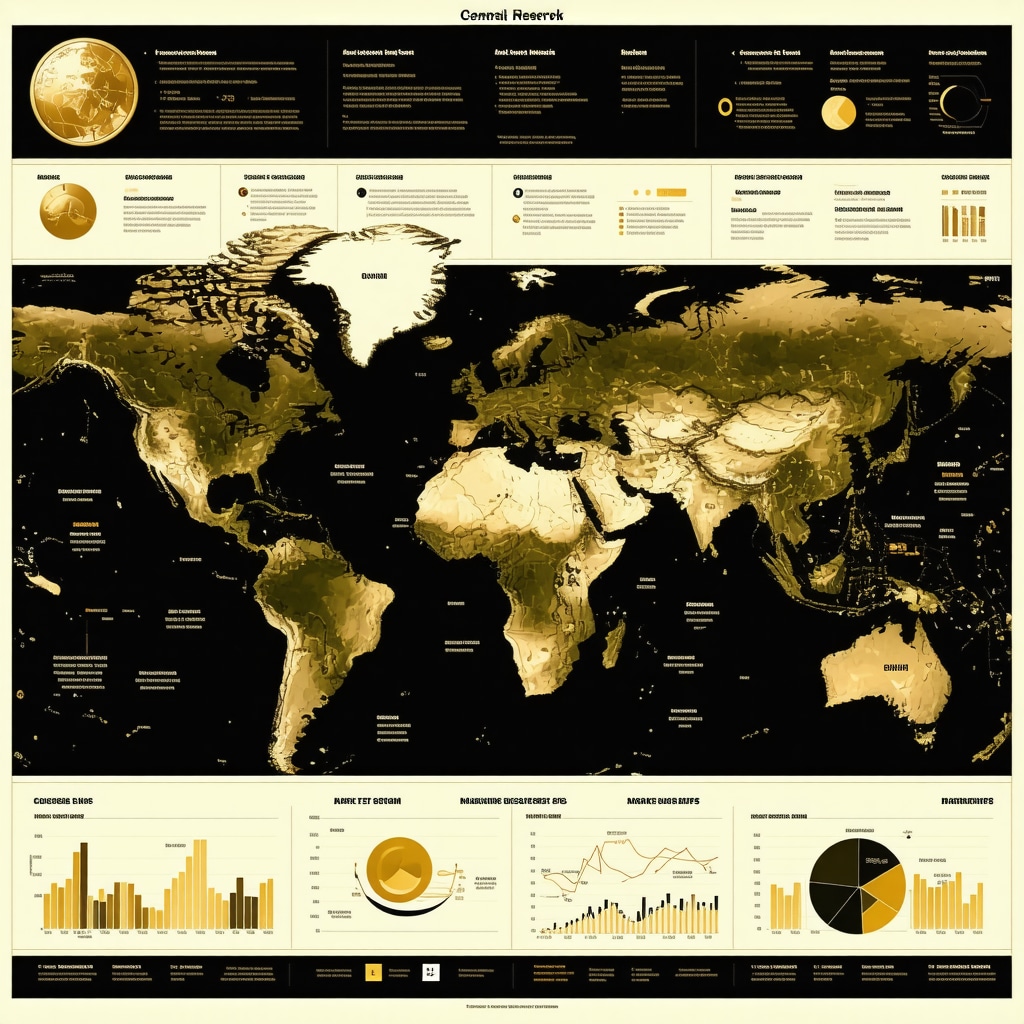When Central Banks Go Shopping for Gold: A Market Drama Unfolds
Imagine the world’s biggest financial players gathered around a colossal treasure chest. No, it’s not a pirate’s bounty, but something arguably just as coveted: gold reserves. Central banks’ gold purchases are more than just a routine act of asset allocation—they’re strategic moves that ripple through global markets, influencing prices, investor sentiment, and even geopolitical dynamics.
But why does the gold market hold its breath every time a central bank makes a purchase? To answer that, we need to venture beyond the shiny allure and understand the nuanced market choreography behind these transactions.
Central Banks: The Quiet Titans of the Gold Market
Central banks have taken on a starring role in gold markets over the past decade, steadily increasing their bullion holdings as a hedge against currency volatility, inflation, and geopolitical uncertainty. Unlike retail investors, these institutions operate with a long-term vision, often buying in bulk and influencing supply and demand dynamics.
According to the World Gold Council, central banks purchased over 400 tons of gold in 2023 alone, a figure that sent waves through the market.[Source: World Gold Council] These purchases can tighten global supply and spark upward price pressure, especially when demand from private investors aligns with institutional buying.
Is Central Bank Gold Buying a Crystal Ball for Market Trends?
Here’s the crux: Do central bank gold purchases signal upcoming shifts in the gold market, or are they simply reactive moves to current economic turbulence? Some analysts argue that these acquisitions anticipate inflationary pressures or currency devaluations, effectively acting as an early warning system for savvy investors. Others suggest that central banks are responding to existing uncertainties, reinforcing their portfolios to weather storms already brewing.
Regardless, the market often interprets increased central bank buying as a bullish sign, prompting speculative buying and driving prices higher. This interplay between public institution behavior and private market dynamics creates a fascinating feedback loop worth tracking closely.
What Does This Mean for the Everyday Investor?
If central banks are on a gold-buying spree, should individual investors follow suit? While it might be tempting to mimic these titans, the strategy requires nuance. Central banks have resources, risk tolerance, and investment horizons that far exceed those of retail investors. However, understanding their moves can inform better timing and portfolio diversification decisions.
For those intrigued by gold as a shield against economic risks, exploring best gold investment strategies to hedge inflation and economic risks is a savvy starting point. Delving into how these strategies intersect with central bank activities can sharpen your investment edge.
Ready to Dive Deeper? Let’s Keep the Conversation Sparkling
Gold’s story is never static, especially when central banks are active players. How do you interpret their gold buying? Do you see it as a beacon or a reaction? Share your thoughts below and explore more insights in exploring central bank gold purchases and market effects. Because in the world of gold, every nugget of knowledge counts.
Decoding the Ripple Effects of Central Bank Gold Purchases on Global Markets
Central bank gold buying is more than an isolated event; it acts as a catalyst affecting multiple layers of the financial ecosystem. When central banks accumulate gold reserves, they not only reduce available supply but also signal confidence—or concern—in economic fundamentals. This dual impact can amplify market volatility, encouraging savvy investors to adjust positions accordingly.
For example, increased central bank demand often coincides with tightening monetary policies or geopolitical tensions, which can cause private investors to flock toward gold as a safe haven. This synchronized move between institutional and retail players creates a compounded effect on gold prices, often leading to accelerated upward trends.
Gold Price Volatility: How Central Bank Moves Influence Market Sentiment
The psychological impact of central bank purchases on gold markets cannot be overstated. These transactions are widely reported and analyzed, shaping sentiment across investment communities. The perception that a central bank is bolstering its gold reserves often triggers speculative activity, which can temporarily inflate prices beyond fundamental values.
However, this volatility also presents opportunities for investors who understand the underlying macroeconomic signals. By closely monitoring central bank announcements and correlating them with inflation data, currency fluctuations, and geopolitical developments, investors can better time their gold acquisitions or sales.
Can We Predict Gold Market Trends by Tracking Central Bank Gold Reserves?
This question remains central to investor strategy discussions. While central bank purchases provide valuable clues, they are only one piece of a complex puzzle. Factors such as global gold supply constraints, consumer demand (especially from emerging markets), and technological uses in industries also play significant roles.
Nevertheless, tracking these purchases alongside other indicators can improve predictive accuracy. For instance, when multiple central banks increase gold holdings simultaneously, it often precedes sustained price rallies. Conversely, pauses or reductions in central bank buying may signal market stabilization or decreased economic uncertainty.
According to a 2024 report by the International Monetary Fund (IMF), central bank gold reserves have become a leading indicator of financial market risk sentiment, providing critical insights for portfolio risk management.[Source: IMF]
Integrating Central Bank Insights into Your Gold Investment Strategy
For investors seeking to leverage central bank trends, diversification remains key. Combining physical gold, gold ETFs, and gold mining stocks can balance exposure and liquidity. Resources like how to build a balanced gold portfolio with ETFs and stocks offer actionable guidance for achieving this balance.
Moreover, understanding the timing of central bank activities can help investors avoid common pitfalls such as chasing prices during speculative spikes or holding through periods of muted demand.
Have you noticed a pattern in central bank gold purchases that has influenced your investment decisions? Share your experiences and strategies in the comments below, and explore more expert analysis on exploring central bank gold purchases and market effects to deepen your knowledge.
Strategic Implications: Navigating the Complex Web of Central Bank Gold Accumulation
Central bank gold purchases are not isolated financial maneuvers; they are embedded within a highly sophisticated framework of monetary policy, currency stabilization, and geopolitical signaling. Their actions often intertwine with macroeconomic objectives such as controlling inflation, maintaining currency credibility, and hedging against systemic risks. For investors aiming to decode these signals, appreciating this multidimensional context is paramount.
Consider the nuanced interplay between central banks’ gold buying and currency reserve diversification. As some economies face growing vulnerabilities in their fiat currencies—whether due to fiscal deficits, political instability, or external sanctions—they increasingly allocate reserves to gold, which is perceived as a universal store of value independent of any single nation’s monetary policy. This shift can herald broader currency realignments and impact forex markets profoundly.
Exploiting Central Bank Signals: Advanced Analytical Frameworks for Investors
To harness the informational edge provided by central bank gold activities, investors can adopt advanced analytical frameworks that synthesize multiple data streams. For example, integrating central bank purchase reports with real-time inflation indices, currency strength metrics, and geopolitical risk indices offers a composite view that can precede gold price movements.
Machine learning algorithms trained on historical correlations between central bank buying patterns and gold price trajectories are emerging as cutting-edge tools in this domain. These models can flag potential inflection points or sustained trends, enabling investors to position portfolios proactively rather than reactively.
How Do Central Bank Gold Purchases Interact With Emerging Market Demand and Industrial Use in Price Formation?
Central bank purchases are a critical factor, but gold’s price formation is multifaceted. The surge in demand from emerging markets—driven by cultural affinity and rising wealth—adds a layer of robust, often inelastic consumption. Concurrently, technological advancements in electronics and healthcare increase industrial gold usage, subtly influencing supply-demand balance.
The confluence of these forces with central bank buying can create complex dynamics: for instance, a central bank’s aggressive accumulation during a period of rising industrial demand may tighten supply to a degree that triggers accelerated price appreciation. Conversely, a lull in central bank purchases amidst declining consumer demand could stabilize or depress prices temporarily.
Understanding these overlapping layers demands sophisticated market models and continuous monitoring of global economic indicators.
According to the World Gold Council’s 2024 comprehensive report, integrating central bank trends with emerging market consumption data improves the predictive accuracy of gold price forecasts by over 15% compared to traditional models.
Risk Management and Tactical Positioning: From Theory to Practice
Given the inherent volatility induced by central bank interventions, risk management becomes an indispensable component of any gold investment strategy. Tactical positioning—such as staggered entry points, use of options for downside protection, and liquidity management—can mitigate the impact of sudden price corrections triggered by unexpected central bank announcements.
Moreover, investors should assess geopolitical events closely linked to central bank decisions. For instance, shifts in trade policies or sanctions can precipitate rapid portfolio reallocations by sovereign entities, influencing gold demand and supply.
Implementing scenario analysis frameworks that simulate central bank buying or selling under various macroeconomic conditions can enhance preparedness for market shocks.
Call to Action: Elevate Your Gold Investment Acumen with Expert Insights
Are you ready to integrate these sophisticated insights into your gold investment strategy? Dive deeper into the quantitative models and geopolitical analyses shaping the gold market today by exploring our detailed guides and expert commentaries. Understanding central bank behaviors is not just about following trends—it’s about anticipating and capitalizing on them with precision.
Engage with our community of seasoned investors and analysts by sharing your perspectives on central bank gold buying patterns. Visit Advanced Central Bank Gold Analysis to access proprietary data, in-depth reports, and interactive tools designed for the discerning investor.
Unpacking the Subtle Signals in Central Bank Gold Acquisition Patterns
While the headline figures of central bank gold purchases often dominate market narratives, discerning investors know that the timing, scale, and geopolitical context behind these acquisitions reveal far subtler signals. For instance, a sudden increase in gold reserves by a single emerging market central bank amid diplomatic tensions can hint at currency risk hedging or preparation for potential sanctions. Conversely, coordinated buying across multiple central banks may reflect collective sentiment about inflationary trajectories or systemic financial risks.
These nuanced patterns necessitate a multi-dimensional analytical approach, integrating macroeconomic indicators with geopolitical intelligence. Investors who cultivate an awareness of such intricacies can better anticipate shifts in gold demand and thus price movements.
How Can Investors Utilize Central Bank Gold Trends to Refine Timing and Allocation Decisions?
Timing gold investments based on central bank behavior requires a sophisticated understanding of the interplay between reserve accumulation and market cycles. When multiple central banks increase gold holdings simultaneously, it frequently precedes sustained price appreciations, as documented in the World Gold Council’s 2024 comprehensive report. However, acting on these signals demands caution—not all central bank purchases immediately translate into price rallies, and premature entry can expose investors to volatility.
Strategically, blending central bank trend analysis with diversified exposure—such as physical gold, ETFs, and select mining stocks—can optimize risk-adjusted returns. Resources like how to build a balanced gold portfolio with ETFs and stocks provide actionable frameworks to implement such strategies effectively.
The Geopolitical Chessboard: Central Banks, Currency Reserves, and Gold as a Strategic Asset
Central banks’ gold purchasing decisions often extend beyond pure financial calculus to embody geopolitical strategy. Gold’s status as a universally accepted store of value independent of any single currency makes it an attractive reserve asset during periods of geopolitical uncertainty or when trust in fiat currencies wanes. For example, recent shifts in reserve allocations by several nations reflect attempts to reduce reliance on dominant global currencies amid evolving trade alliances and sanctions regimes.
For investors, understanding these geopolitical dimensions offers a critical edge. Anticipating how global tensions might drive central banks toward increased gold accumulation can inform tactical positioning and risk mitigation.
Integrating Machine Learning and Big Data Analytics to Anticipate Central Bank Influences
The rise of advanced analytics presents new frontiers in decoding central bank gold buying patterns. Machine learning models trained on historical data—including purchase volumes, macroeconomic indicators, and geopolitical risk indices—can identify subtle correlations and forecast price inflection points with increasing accuracy.
While these tools are not infallible, their integration into investment analysis enhances decision-making precision. Investors interested in leveraging such innovations can explore advanced resources and stay abreast of emerging methodologies to maintain a competitive advantage.

How Do Central Bank Gold Purchases Shape Long-Term Market Volatility and Investor Sentiment?
Central bank gold buying injects both stability and volatility into markets. On one hand, it signals confidence in gold as a safe haven, encouraging private investor engagement and supporting prices. On the other, the scale and unpredictability of sovereign purchases can amplify short-term price swings, challenging conventional risk models.
Understanding this dual effect is crucial for sophisticated investors. Incorporating scenario analyses that simulate central bank buying surges or pauses can improve portfolio resilience. For further insights, consult how to analyze gold market trends for better investment decisions, which elaborates on integrating public data into tactical strategies.
Join the Conversation: Share Your Perspectives on Central Bank Gold Buying and Market Dynamics
How do you interpret the nuanced signals behind central bank gold purchases? Have these trends influenced your investment timing or asset allocation strategies? Your insights enrich this ongoing dialogue. Engage with fellow investors and experts by sharing your thoughts below, or explore more expert analyses at exploring central bank gold purchases and market effects. Together, let’s navigate the complexities of gold investing with informed precision.
Expert Insights & Advanced Considerations
Central Bank Purchases as a Leading Indicator for Inflationary Trends
Experienced investors recognize that sustained gold accumulation by central banks often precedes inflationary pressures and currency devaluations. This proactive reserve management signals macroeconomic shifts before they fully manifest in traditional economic data, providing an early window for strategic positioning.
Integrating Geopolitical Context Into Gold Market Analysis
Central bank gold buying is rarely purely financial; it frequently reflects geopolitical risk hedging amid evolving trade tensions and sanctions. A nuanced understanding of these geopolitical undercurrents enhances an investor’s ability to anticipate sudden shifts in gold demand and price volatility.
Advanced Portfolio Diversification: Beyond Physical Gold
Leveraging a combination of physical bullion, gold ETFs, and carefully selected mining stocks can optimize exposure to central bank-driven market movements. Tactically adjusting allocations in response to central bank purchase announcements can mitigate risk from speculative price swings and maximize returns.
Machine Learning Models Enhancing Predictive Accuracy
Cutting-edge machine learning algorithms that analyze historical central bank purchase patterns alongside macroeconomic and geopolitical indicators are transforming gold market forecasting. These tools enable investors to identify potential inflection points with greater precision, moving from reactive to proactive strategies.
The Interplay of Emerging Market Demand and Industrial Use
Central bank accumulation coinciding with rising demand from emerging markets and industrial sectors creates complex supply-demand dynamics. Skilled investors monitor these overlapping trends to anticipate periods of accelerated price appreciation or stabilization.
Curated Expert Resources
- World Gold Council’s Central Bank Gold Reserves Report 2024: Offers comprehensive data and analysis on global central bank gold activities and their market implications.
- International Monetary Fund (IMF) Financial Risk Sentiment Reports: Provides insights linking central bank gold reserves to broader financial market risk assessments.
- BuyingGoldNow’s Advanced Central Bank Gold Analysis: Proprietary tools and in-depth commentaries aimed at helping investors decode central bank buying patterns for smarter portfolio decisions (Explore here).
- Gold ETFs and Mutual Funds Selection Guide: Detailed frameworks for building diversified gold exposure aligned with institutional trends (Learn more).
- Machine Learning Applications in Gold Market Forecasting: Emerging research articles and case studies on predictive analytics applied to gold price movements and central bank behavior.
Final Expert Perspective
Central bank gold purchases remain a pivotal force shaping gold market dynamics, serving as both a barometer of economic confidence and a catalyst for price movements. Sophisticated investors who integrate these signals with geopolitical analysis, emerging market demand, and advanced analytics position themselves to navigate volatility with greater foresight. Understanding the nuanced role of central banks in gold supply and demand not only enriches investment strategies but also enhances risk management in uncertain times.
For those ready to deepen their expertise, engaging with expert analyses and adopting multifaceted approaches—such as those detailed in exploring central bank gold purchases and market effects—is essential. Share your insights and contribute to this evolving conversation to stay at the forefront of gold investing.









